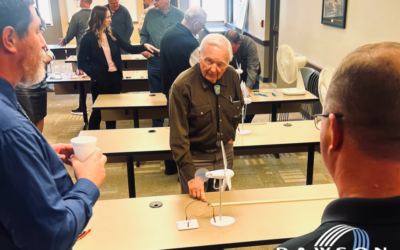
As a not-for-profit utility, Dawson PPD focuses on cost-effectively extending the life of its existing facilities while maintaining adequate levels of safety and reliability. Testing wooden poles helps the District ensure reliability and long life of its equipment, saving customers money in the long run.
Traditionally, pole testing involved a hammer for sounding, a shovel for digging around the base and drilling holes to test for decay. Today, Dawson PPD hires a contractor that uses a scientifically-based system called POLUX as a less-invasive and more accurate form of testing.
POLUX works by sending two, three inch long probes the size of an eight-penny nail into the base of the utility pole. This is the most vulnerable point where decay is most likely to occur on a pole. The probes measure resistance and moisture content of the pole. This information, along with the type of wood the pole is made of and how it was treated are run through a computer program with the pole’s GPS location recorded.
Typically, Dawson PPD uses a Southern Yellow Pine tree for its poles, which should have a resistance of 8,000 pounds per square inch when new. If the measurement falls below 50 percent of the recommended resistance, in this case 4,000 PSI, the pole is marked for replacement.
All of Dawson PPD’s poles are tested every 10 years on a rotating schedule with 10,000-11,000 poles tested annually.
OTHER NEWS
Employee appreciation days observed in April
April 8, 2024 – Lineworker Appreciation Day. April 24, 2024 – Administrative Professionals Day.
Between the lines: ‘Watts’ the hitch with wind and solar?
I think being able to flip a switch, plug in a charger and not worry about reliability and affordability is my chosen path.
Dawson PPD’s board considers finances and safety
Dawson Public Power District’s board held their regular meeting on March 12. During the financial report, Carmen Ackerman, Manager of Finance and Administration, reviewed the 2023 margins. She suggested the district keep the money in an unrestricted account,...



